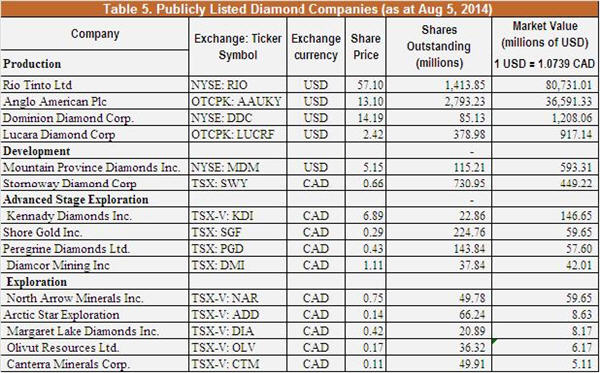Summary
Introduction – all hell for a basement?
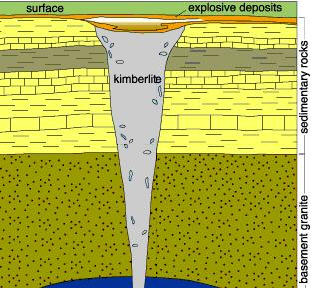 Diamonds, crystallised carbon, are the hardest naturally occurring material. The optimal environment for the formation of diamonds requires consistent heat and pressure, which is found beneath stable thick parts of the earth’s crust known as cratons. Most primary (non-alluvial or coastal) diamond discoveries are hosted within rock formations older than 2.0 billion years. Diamonds form at depths greater than 160 km below surface and are brought to the surface through violent volcanic activity that has occurred at various intervals through geologic time. During ascent through the lithosphere (upper mantle and crust), the potentially diamond infused magmas accumulate minerals known as KIMs (kimberlite indicator minerals). Kimberlite, an ultrabasic igneous rock made up of at least 35% olivine, form as their volatile rich magmas cool upon their emplacement into the surface and near-surface environment, commonly in the shape of a pipe or champagne flute, and sometimes in the shape of a champagne coupe (as in Saskatchewan).
Diamonds, crystallised carbon, are the hardest naturally occurring material. The optimal environment for the formation of diamonds requires consistent heat and pressure, which is found beneath stable thick parts of the earth’s crust known as cratons. Most primary (non-alluvial or coastal) diamond discoveries are hosted within rock formations older than 2.0 billion years. Diamonds form at depths greater than 160 km below surface and are brought to the surface through violent volcanic activity that has occurred at various intervals through geologic time. During ascent through the lithosphere (upper mantle and crust), the potentially diamond infused magmas accumulate minerals known as KIMs (kimberlite indicator minerals). Kimberlite, an ultrabasic igneous rock made up of at least 35% olivine, form as their volatile rich magmas cool upon their emplacement into the surface and near-surface environment, commonly in the shape of a pipe or champagne flute, and sometimes in the shape of a champagne coupe (as in Saskatchewan).
Kimberlites occurring in the Canadian tundra have been affected by the erosion dynamics of continental glaciers during the period of Pleistocene glaciation, which only receded over the last twenty thousand years. These erosion dynamics have in effect smeared these KIMs hundreds of kilometers from their source kimberlite intrusions, distributing evidence of that source as a ‘mineral train’ of fragments that follows the movement of the ice away from the intrusion. Exploration geologists attempt to delineate and follow the KIMs back to the kimberlite by pattern sampling of soil and till (glacial deposits), and recovering the KIMs by laboratory processing of the samples. Since not all kimberlites are diamond bearing, geologists refine their searches by analysing the KIM grains for their chemistry, which they then assess using industry standard mineral chemistry plots so as to rank those KIM trains to increase their chances of discovering kimberlites that may host diamonds. Kimberlites tend to occur in “clusters” of intrusions of similar geologic age, with multiple proximate clusters referred to as a kimberlite field. A good primer on kimberlites may be found on the Natural Resources Canada website.
There are many reports that focus in depth on the chemistry of indicator minerals. However, the simple fact is that the odds of discovering an economic diamond deposit are low, even when kimberlites are being found. Globally, approximately 20% of kimberlites are diamondiferous (i.e. containing some diamonds, including microscopic diamonds that the industry refers to as micro diamonds), with roughly 1% of all kimberlites discovered hosting an economic diamond deposit. The odds in Canada, though still poor, are materially above the world norm. As of 2002, over 50% of kimberlites discovered in Canada were diamondiferous; while Lac de Gras had recorded a prodigious 5% of all kimberlites discovered to host an economic diamond deposit. Clearly, diamond exploration is not for the faint of heart and presents significant risk for even the most seasoned geologist.
The Strokes – an investment theme takes shape
As a non-geologist, I believe there are five important concepts for evaluating diamond exploration and development companies:
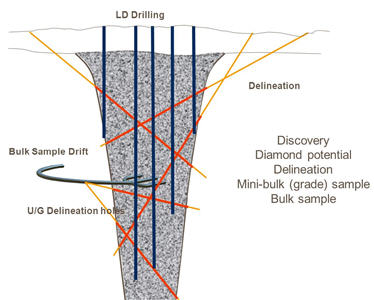 An advantage of high grade deposits is that assessing their economic potential is substantially more cost effective to achieve: specifically, the assessment of grade distribution can be made using smaller drill diameters (for example if a geologist determined that a 20cm diameter drill would suffice for a 3 carat per tonne ‘mini-bulk’ grade sampling program, he would need a 1.1m diameter drill to accomplish comparable diamond recovery were the grade to be estimated at 0.1 carats per tonne); similarly to recover a parcel of (say) 10,000 carats to facilitate an estimate of the average diamond price, a 3,400 tonne ‘bulk sample’ would suffice for the 3 carat per tonne kimberlite pipe, whilst 100,000 tonnes would be needed from a 0.1 carat per tonne kimberlite.
An advantage of high grade deposits is that assessing their economic potential is substantially more cost effective to achieve: specifically, the assessment of grade distribution can be made using smaller drill diameters (for example if a geologist determined that a 20cm diameter drill would suffice for a 3 carat per tonne ‘mini-bulk’ grade sampling program, he would need a 1.1m diameter drill to accomplish comparable diamond recovery were the grade to be estimated at 0.1 carats per tonne); similarly to recover a parcel of (say) 10,000 carats to facilitate an estimate of the average diamond price, a 3,400 tonne ‘bulk sample’ would suffice for the 3 carat per tonne kimberlite pipe, whilst 100,000 tonnes would be needed from a 0.1 carat per tonne kimberlite.The quoted size of the global rough diamond market in any given year will vary slightly depending on the estimate. For example, in 2012 the Kimberly process recorded a market value of U$12.6 billion, while Bain & Company Inc. estimated revenues at U$14.8 billion. There exist significant barriers to entry in diamond mining. In fact, only four large players control approximately 80% of global rough diamond production. It is difficult to access detailed market data as ALROSA, De Beers, Rio Tinto, and Dominion Diamond treat this information as proprietary. Despite this, there is a compelling narrative for diamond explorers as ore production from several historically significant mines has stopped (Mir) or is falling (Argyle). Additionally, Bain & Company reports profit margins for rough diamond production has remained healthy at between 16-20%. The firm also expects demand to achieve a robust compound annual growth rate (CAGR) of 5.1% through 2012 to 2023.[1] This combination of factors should help diamond exploration investment in Canada rebound from C$78.9 million in 2012, which was a contraction of 14% from 2011.
Historical Context – Canada is the latest frontier
Prior to 1870, diamonds were found exclusively in alluvial deposits, primarily from India. However, in 1867 diamonds were discovered in kimberlite pipes located near the town of Kimberley, South Africa; and by 1887 De Beers exercised monopoly control over the global industry that remained unrivaled for nearly 100 years. Mining from pipes has led to the exponential increase in the annual global market supply of diamonds from less than 1 million carats in 1870 to a peak of 176.7 million carats in 2005. Advancements in geological understanding combined with new mining technology (machines) opened the industrial market for diamonds. However, due to advancements in synthetic diamond manufacturing, mined production of boart (industrial diamonds) could be considered as a by-product that is inconsequential to the economics of diamond mining.
Throughout 1870 to 1960, Africa was responsible for nearly 100% of global production, and many experts believed economic diamond deposits did not exist in Canada. Russia’s Mir Mine in Siberia, which started production in 1957, likely helped changed this perception; as well as, Australia’s Argyle Mine. Commercial production at Argyle began in 1986 and at its peak in 1994, Argyle accounted for nearly 40% of global annual production as measured by weight.
In contrast, Canada is a relative newcomer on the global stage for rough diamonds. Academic propositions for diamond deposits in Canada began around the turn of the 20th Century; yet exploration did not begin in in earnest until 1960, and it would take the better part of 20 years to refine exploration techniques using an understanding of glaciation and chemistry. Canada, likely represented a steep learning curve for even the heavyweight foreign diamond miners. Successful diamond exploration in northern Canada was materially challenged by several factors, including:
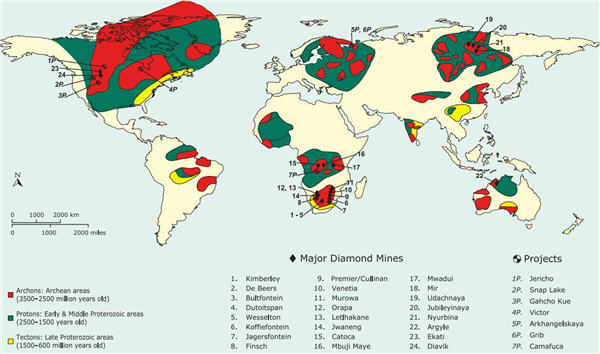
These challenges would take some time to overcome and adapt to. However, for Lac de Gras, home to the world class Ekati and Diavik mines, diamond bearing pipes were discovered in 1991. Production from Canada’s first diamond mine – the Ekati – commenced in 1998, with the Panda pipe being the fourth most valuable in the world.
Material mine production from Russia, Australia, and eventually Canada, and a bout of persistent high inflation in Israel during the 1970’s all contributed to the eventual demise of the De Beers cartel. Russia is now the global leader of mined diamond production by total carat weight produced.
The Global Financial Crisis – value perseveres as output falters
Global annual mine production has materially fallen from approximately 177 million carats in 2005 to only 130 million carats in 2013 (Chart 1). The global annual decline was partly offset by a significant increase in production from Zimbabwe. However, Zimbabwe production fell in 2013 to 10.4 million from 12.1 million carats a year earlier, and expectations for 2014 project an additional decrease in supply.[1]Interestingly, the value of the global diamond market, measured in USD, has remained on an upward, though volatile, trend throughout 2004 and 2013 with an average and median annual value of U$11.9 and U$12.0 billion, respectively. The outlier in the population set was 2009, which saw the market for rough diamonds collapsed to U$8.3 billion in the aftermath of the Global Financial Crisis; though the recovery was swift and sustained reaching U$14.1 billion in 2013. Gem quality diamonds represent only 20-25% of total annual mined output by weight, yet account for the majority of the value.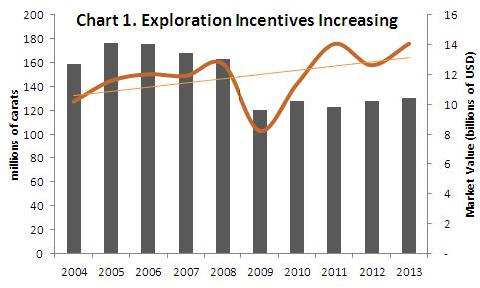
Price Growth – the song remains the same
De Beers marketing is responsible for arguably one of the greatest market creations in the history of capitalism, summed up in one simple slogan – “A Diamond Is Forever”. The US has consistently been the largest consumer (Chart 2), though Canada in 2000 lead the US on a per capita basis.[1] In North America, approximately 70-80% of women own at least one piece of diamond jewellery. Nicky Oppenheimer, former De Beers’ deputy chairman, once famously stated, “A gemstone is the ultimate luxury product. It has no material use.”[2] As there is no more intrinsic value for gem-sized diamonds over their industrial counterparts, the exponential price increase would seem somewhat peculiar. Therefore, the price of gem quality diamonds depends not on the diamonds themselves but on the value bestowed by buyers, or perhaps ‘captured’ by the jewellery industry.
In this light, gem quality diamond prices hinge on three material variables:
1. Discretionary income growth – global growth remains positive, albeit more modest than the recent past, indicating a positive long-run trend for discretionary incomes. As of 2012, the Americas represent 37% of global retail demand, while China – the most important market for near-term future demand growth – was 11%. The Americas proportion of world demand should continue to shrink as long as China continues to grow the ranks of their upper-middle class (Table 1)
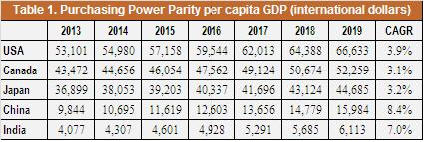
2. Supply – falling ore production from several major diamond mines should mean continued global supply constraint and higher prices, all else equal (Table 2). Since 1870, records indicate there have been roughly 30 large, successful operating mines globally. As previously indicated, the economics of diamond mining depends on much more than the mere occurrence of diamond.
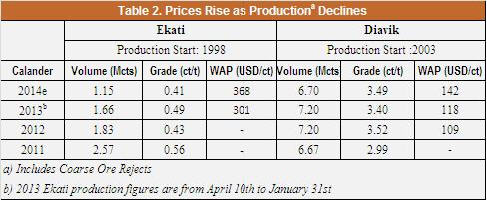
3. Cultural – continued adoption and integration of “western” values, such as diamond engagement rings in emerging markets with large populations should continue to propel industry growth (Chart 2). A good example is the success of De Beers Diamond Jewellers, an ongoing joint venture between De Beers and LVMH Moet Hennessy Louis Vutton. LVMH reported their largest market for watches and jewelry in 2013 was Asia (excluding Japan), which represented 27% of total revenue.
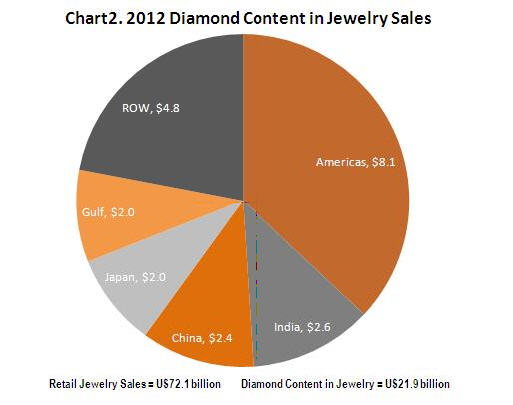
It is this author’s expectation that price volatility will reflect global economic trends going forward. Until 2000, De Beers used its Central Selling Organisation (CSO) – essentially a clearing house for global trade – to control diamond prices. De Beers no longer directly acts in this capacity and in the absence of a buyer of last resort the weighted average prices of rough diamonds should be expected to remain volatile as global uncertainty remains.
Diamond Exploration – why Canada?
The proportion of gem quality diamonds tend to be quite pronounced in alluvial deposits, whereas the primary source kimberlite pipes tend to have a wider range of qualities, including a significant share of micro, and industrial diamonds. However, with the majority of industrial diamonds being synthetic, new diamond deposits need to contain sufficient quantities of gem and near gem quality diamonds to be considered economic; specifically, a significant tonnage with relative high diamond concentration. This is where Canada has found a niche position.
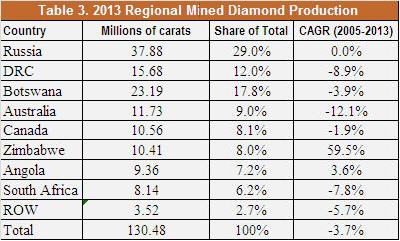 In 2013, Canada was a distant fifth largest producer of diamonds by weight (Table 3), yet third by value (Table 4). Currently, diamond production in Canada comes from 4 mines:
In 2013, Canada was a distant fifth largest producer of diamonds by weight (Table 3), yet third by value (Table 4). Currently, diamond production in Canada comes from 4 mines:
Ekati, Diavik, and Snap Lake are all located in the Northwest Territories (NWT); and Victor in Northern Ontario.
Clearly, Lac de Gras in the NWT is the standout among Canadian production centers. Diamond bearing kimberlites in this district are of relatively small tonnage by world standards, yet present as high grade deposits. The combination of improved understanding of the regional glacial geology and distributions of KIM mineral trains and their chemistry, are creating a positive environment for junior exploration to discover potentially high grade pipes with adequate tonnage. Infrastructure continues to be developed while existing processing capacity will require ore in the future. The potential to find high grade deposits may provide discoveries that prove easier to define and are more cost effective to evaluate.
There are no universally available statistics related to the odds of successfully intersecting kimberlite per drill attempt; however, several Canadian diamond experts have suggested to me that the odds for an experienced, well-funded team operating in a familiar environment could be approaching 50%.
Importantly, Canada, including the NWT, is widely considered more attractive from both a geopolitical and investment risk perspective, when compared with many other large diamond producing countries. As a foreign investor, how safe is capital investment in Angola? Democratic Republic of Congo? Russia? Canada is one of the few large diamond producers with exploration potential, rule of law, infrastructure, technical expertise, and efficient capital markets.
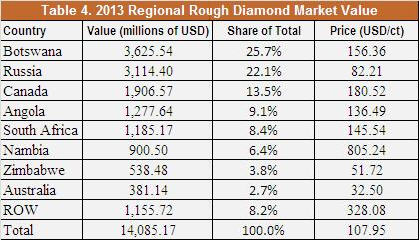
Owing to the challenging nature of diamond prospecting, the exploration team is the most valuable asset an exploration enterprise possesses. The team needs to have a good understanding of the geology and chemistry of the prospective region, patience and access to capital. One of the obvious, yet overlooked issues from investors is the need for continued land acquisition while following indicator trains. Sometimes the prospective land will only be available in the future, if at all.
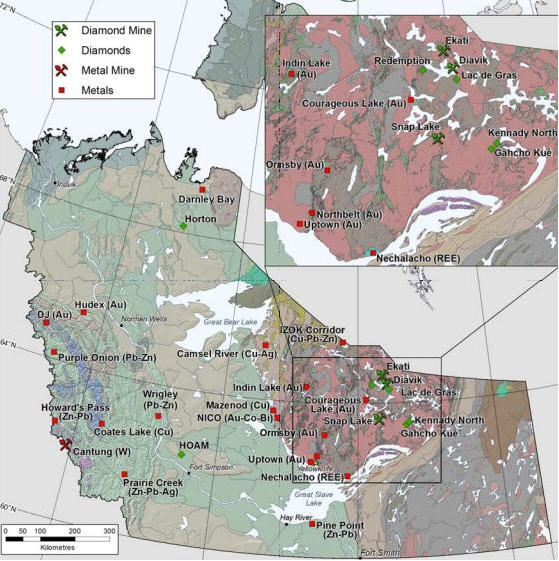
Gahcho Kué – demonstrating continued Canadian diamond potential
Evaluation of Gahcho Kué diamond bearing kimberlites began in 1995 and is currently advancing through the regulatory process. Gahcho Kué, is a joint venture between De Beers Canada Inc. and Mountain Province Diamonds Inc., and is located at Kennady Lake, in the southeast of the Slave Craton, approximately 150 km southeast of the Ekati and Diavik mines and 80 km east of Snap Lake in the NWT.
The Gahcho Kué project consists of four diamond bearing kimberlites, with an aggregate resource estimate 33.8 million tonnes of ore containing 56.5 million carats yielding a grade of 1.67 carats per tonne indicated, and an additional 11.3 million tonnes of ore containing 18.5 million carats inferred.
Concluding Remarks
Due to clustering potential, exploration in areas with proximity to existing diamondiferous kimberlite should benefit. There are still highly prospective targets in the NWT as claims in the Slave Craton with proximity to Diavik and Ekati were highly sought after during the diamond exploration boom of the 1990’s. However, during the exploration ebb since 2000 many claims in the region have been relinquished by exploration companies that were unable to raise fresh capital. With interest returning the above average grade experienced in the Slave geological province is a strategic advantage for junior exploration enterprises with limited budgets.
Zimtu believes interest is returning to diamonds. Canada, with increasing rough diamond prices, improved glacial understanding, and advancements in exploration techniques should attract investment for diamond exploration. Though not all-inclusive, we have attached a list of US and Canadian publicly traded diamond companies (Table 5).
